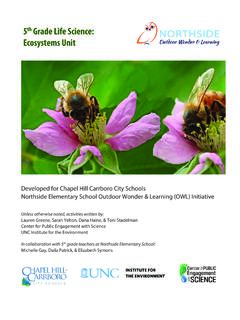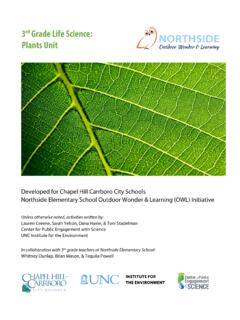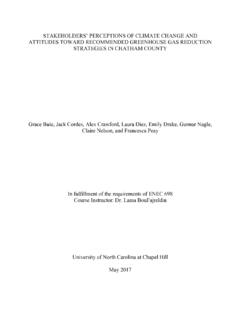Transcription of The Black Soldier Fly How-to-Guide
1 Black Soldier Fly How-To Guide 1 of 12 The Black Soldier Fly How-to-Guide ENST 698-Environmental Capstone Spring 2013 Team Members: Neill Bullock, Emily Chapin, Austin Evans, Blake Elder, Matthew Givens, Nathan Jeffay, Betsy Pierce, and Wood Robinson Advisors: Susan Caplow; Elizabeth Shay, PhD UNC-Chapel Hill John Mattox, PhD Fayetteville State University This paper represents work done by a UNC-Chapel Hill undergraduate student team. It is not a formal report of the Institute for the Environment, nor is the work of UNC-Chapel Hill faculty. Black Soldier Fly How-To Guide 2 of 12 Table of Contents I. Table of Contents 2 II. Statement of Purpose 3 III. Introduction 3 IV. Optimal conditions for BSFL 4 Temperature Diet Humidity Additional environmental conditions V. Where to get BSFL 5 VI. Determining scale (calculator) 5 VII. How to build a BSFL feeding operation 6 Large Scale Medium to Small Scale VIII.
2 Attracting your own colony of Black Soldier Flies 8 Natural Distribution of Black Soldier Flies Black Soldier Breeding IX. How to Build an Indoor Black Soldier Fly breeding operation 9 X. Feasibility of off-season breeding 10 XI. Value of BSFL and their byproduct 11 XII. Works Cited 12 Black Soldier Fly How-To Guide 3 of 12 Statement of Purpose This How-to Guide is meant to serve as a resource for farms of all types and sizes and individuals who are interested in implementing a Black Soldier fly-based waste management system. It was produced by a group of eight students at the University of North Carolina at Chapel Hill as part of their senior capstone project with the support of UNC s Institute for the Environment and Pickards Mountain Eco-Institute in Orange County, North Carolina. Introduction Black Soldier flies are small, harmless insects that have the potential to provide promising solutions to two of modern agriculture s growing problems: the high cost of animal feed and the disposal of large amounts of animal waste.
3 Many farms now operate as linear systems, purchasing animal feed and then paying to eliminate waste from farm animals. Recent research has indicated that Black Soldier fly may be instrumental in closing the loop between animal waste and animal feed (Watson, 2005). Black Soldier fly larvae (BSFL) will eat nearly any kind of organic waste ranging from animal waste to food scraps. As the BSFL mature, they grow into -inch-long grubs, at which point they climb out of their food source and turn into pupae. The pupae can immediately be fed to chickens and are a good source of protein. They can also be dried and processed into feed for use at a later time. Small composting operations also allow them to turn into flies and breed, propagating the population. Black Soldier Fly Larvae Black Soldier Fly Adult Black Soldier flies are beneficial in several ways. The adults are not attracted to human habitation and thus pose a significantly lower risk of disease transmission than other fly species (Newton et al.)
4 , 2005). Furthermore, they prevent houseflies and other insects from laying eggs in the material inhabited by BSFL. The adults do not have digestive organs, relying on stores of body fat from the larval stage. Their short life cycle makes them a reliable source of food for chickens and potentially other farm animals. Previous work has also shown that Black Soldier flies are effective in reducing the mass as well as nutrient and moisture content of various kinds of organic waste. Black Soldier Fly How-To Guide 4 of 12 This how-to guide will help anyone interested in using BSFL for composting, animal waste reduction, or feeding animals. This guide suggests a few potential set-ups, depending on the desired scale of BSFL cultivation. It also outlines many of the logistics of raising BSFL successfully, including where to get BSFL to start an operation, how to build the set-up, how BSFL can be used to substitute chicken protein supplement, and how to breed BSFL in captivity.
5 Optimal conditions for BSFL Temperature The optimal temperature at which BSFL consume their food is around 95 F. The minimum temperature for survival is 32 F for no more than four hours, whereas the maximum temperature allowing survival is 113 F. The larvae will become inactive at temperatures less than 50 F and temperatures higher than 113 F, where their survival decreases dramatically. The best range of temperature for the larvae to pupate is from 77 to 86 F. For mating purposes, optimal temperature is around 82 F (Zhang, 2010). Diet BSFL can tolerate a widely varied diet. The BSFL feed on many kinds of organic waste such as table scraps, composting feed, and animal manure. They can also survive off of coffee grounds for a few weeks, but coffee grounds are not a sustainable diet. The caffeine from the coffee grounds helps to boost the metabolism and makes the grubs more active. A diet combining kitchen scraps and coffee grounds may help to boost their metabolism.
6 The BSFL have a limited ability to process any animal products such as meat and fat. Humidity Black Soldier fly larvae develop most rapidly at 70 percent humidity. The rate of weight loss for the BSFL increases with decreasing humidity. The optimal humidity for Black Soldier fly mating is around 30 to 90 percent. It is very important to monitor humidity for captive rearing and breeding. We found that it is especially important to keep the grubs feeding medium at a proper moisture level not so dry that it cements the grubs into the feed, and not so wet that they cannot breathe through the pores in their exoskeleton. Additional environmental conditions BSFL do not survive well in direct light or in extreme dry or wet conditions. They prefer to be 8-9 inches deep in their food source. If they are too far below the surface, they will perform little bioconversion. Female flies avoid any sites that are anaerobic when trying to lay eggs.
7 Black Soldier Fly How-To Guide 5 of 12 Where to get BSFL Black Soldier fly larvae can be purchased from the Phoenix Worm Store. You can reach their webpage by following this link: The name Phoenix worms is a term commonly used for BSFL sold for pet feed. The Phoenix Worm Store guarantees live delivery of your order when the daytime temperatures are between 35 and 85 F. You can order varying quantities and sizes of BSFL from this company. When deciding on the quantity of BSFL to order, consider the time frame for getting an operation running at the desired capacity. To reach a large capacity in a short amount of time, consider buying the larger quantity (600+ for $ ). For most cases, the smallest amount (100+) will be sufficient and only costs $ The portions received are very generous. Determining scale (calculator) In order to determine the scale we needed to apply to Pickards Mountain to fully replace their protein supplements for chicken feed, we created a calculation tool using the amount of feed they currently buy & the percentage of raw protein in it.
8 This turned out to be 100 lbs at 16%. According to a study performed in Texas by ERS International (ERSI 2008), BSFL are composed of protein. Using the amount of protein we needed to replace each week from their feed, we determined that a little over 17 kilograms of larvae would be necessary. According to the same study, a diagram of the area needed showed ratios of the input of waste and the output as five to one. Using the same proportions, we determined that about 86 kilograms of waste per week is needed to cover an area of m2. We also determined that if we were able to produce million larvae, we would be able to efficiently remove that much waste per week. Using this data, we would be able to create a structure that, should we produce sufficient larvae, would grow and harvest enough BSFL to replace PMEI s chicken feed protein supplement. This calculation can be run by embedding the following lines of code into an html website.
9 <html> <head> Input desired protein form here: <!-- This will change the wording above the text box --> <br> </br> <div id='main'> <form onsubmit="return redirect()"> <input id="search_form_input" type="number" name="query" /> kg/m^2 <!-- This will change the wording next to the text box --> <input type="submit" value="Calculate" /> </form> Black Soldier Fly How-To Guide 6 of 12 </div> <script type="text/javascript"> function redirect() { var query = ('search_form_input').value; if (query != '') { // The variables below are fine, but the numbers can change var grubs = (query * ); var tub = (query * ); var grubtub = (query * ); ("You will need approximately " + grubs + "kg of waste to feed approximately " + tub + " grubs. You will need " + grubtub + " m^2 area for your grub tub."); } return false; } </script> "Be sure to hit refresh in order to input new calculations" <!
10 -- This will change the wording below the text box --> </head> </html> How to build a BSFL feeding operation The first step is to determine the scale of the operation for BSFL feeding based on the amount of waste that is produced or the quantity of chicken feed that is desired. See the previous section for more information on how to determine the scale of your operation. Large Scale Large-scale operations will likely be classified as Animal Feed Operations (AFO) which can include swine, cattle, and poultry. 1 Materials will include concrete and wood to form the basin, gutter/PVC piping, and 5 gallon collection buckets (see description for information on automation). 2 Costs are highly variable depending on setup and scale. Black Soldier Fly How-To Guide 7 of 12 This large-scale design is based on a study done by NC State researcher Wes Watson. The researchers found that Black Soldier Flies are most easily managed in concrete basins directly under caged layers of swine (Watson).






